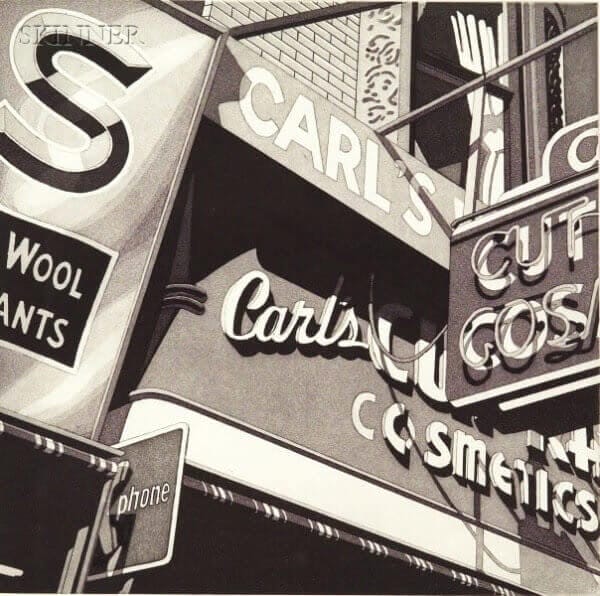Cottingham Robert
Born in 1935 in Brooklyn, New York, Robert Cottingham is renowned for his artistic exploration of urban American landscapes, focusing on building facades, neon signs, movie marquees, and storefronts. After serving in the U.S. Army from 1955 to 1958, Cottingham pursued his passion for art at Pratt Institute in Brooklyn, where he earned a Bachelor of Fine Arts in 1963.
Cottingham’s professional career commenced as an art director at the advertising agency Young and Rubicam in the early 1960s. His time in advertising informed his interest in the intersections of art and commerce and significantly influenced his artistic direction. Although often associated with the Photorealism movement, Cottingham preferred to describe himself as a realist painter in a tradition that traces back to American artists like Stuart Davis, Charles Demuth, Edward Hopper, and Charles Sheeler.
In 1964, Cottingham relocated to Los Angeles, where the vibrant and eclectic environment of the West Coast metropolis inspired him to focus seriously on painting. Captivated by both the glamour of Hollywood and the grittiness of downtown LA, Cottingham sought to capture the city’s unique atmosphere—rich with relics of a bygone commercial era.
By 1968, Cottingham left the advertising world to dedicate himself entirely to painting. He began incorporating photography into his process, using it initially as a reference point. He would project images onto gridded paper, translating them into black-and-white drawings to refine the tonal range between light and shadow. His final compositions involved projecting these images onto canvas, organized according to a grid—a method that emphasizes his focus on the urban American vernacular rather than mere photo-realistic replication.
Cottingham’s work evolved over the decades, expanding in complexity and scope. In the late 1970s and 1980s, his urban landscapes became broader, capturing entire neighborhoods. During the late 1980s and early 1990s, he extended his iconography to include trains and railroad imagery. From the late 1990s, vintage typewriters became a recurring subject of exploration.
His works draw inspiration from the techniques of advertising, often emphasizing typography and the psychological impact of words. Cottingham’s large-scale works resonate with the influences of James Rosenquist, and his interest in text suggests parallels with artists like Robert Indiana and Jasper Johns.
Throughout his career, Cottingham shared his expertise through teaching roles, including positions at the Art Center College of Design in Los Angeles and the National Academy of Design in New York. He was also an artist in residence at Wesleyan University in Connecticut.
Cottingham’s works have been featured in significant exhibitions worldwide, including Documenta in Kassel, West Germany, the Serpentine Gallery in London, the Centre national d’art contemporain in Paris, the Whitney Museum of American Art in New York, and the Deutsche Guggenheim in Berlin.
Robert Cottingham continues to live and work in western Connecticut. His artistic legacy, characterized by a profound exploration of American vernacular culture through a blend of realism and pop art, remains influential in contemporary art circles.
Carls , 1977
